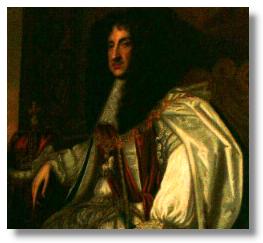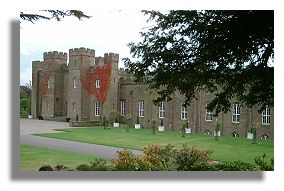
Early Years
Charles II was born at St James's Palace in London on 29 May, 1630. He was the second son of King Charles I and Henrietta Maria (the sister of King Louis XIII of France). But on the death of his elder brother he was created Prince of Wales and became heir to the throne.
His father arrogantly believed in the "Divine Right of Kings" and after a confrontation with the Parliament (which he had suspended for eleven years), Civil War broke out. The King's forces were defeated at the Battle of Edgehill in 1645 (watched by the Prince of Wales and his younger brother James) and again at the Battle of Naseby in 1646. The young Princes were sent to France for safety while the final acts of his father's life were played out in England.
King Charles I was captured by the Scots who turned him over to the English authorities. He was executed in 1649. Many in Scotland were dismayed at the execution of the king and had pleaded for clemency. The Scottish Parliament declared Charles II to be king of Scotland. With the death of the Marquis of Montrose in May 1650, Scotland lacked a good military leader. Indeed the Scottish army was formed more on the basis of religious conformity than military prowes. Consequently, when Cromwell came north in September 1650, he defeated the Scots at Battle of Dunbar and swept across the country.
Coronation and Exile
 In order to have a chance of securing his throne, Charles II solemnly accepted the Protestant "Deed of Covenant" which set aside the interference of the monarch in religion and also rejected Catholicism. Charles came to Scotland and was crowned King of Scots at Scone (pictured here) on 1st January 1 1651. This was the last coronation on Scottish soil.
In order to have a chance of securing his throne, Charles II solemnly accepted the Protestant "Deed of Covenant" which set aside the interference of the monarch in religion and also rejected Catholicism. Charles came to Scotland and was crowned King of Scots at Scone (pictured here) on 1st January 1 1651. This was the last coronation on Scottish soil.
With more bravado than sense, Charles led an army south into England. Once they were far from Scotland (and Cromwell had assembled a big enough army) they were routed at the Battle of Worcester on September 3, 1651. 3,000 Scots were killed and 10,000 taken prisoner. Those who survived, were sold to the American plantations. After a number of narrow escapes, Charles made his way to France. He remained there and in the Netherlands for nearly nine years.
The Puritans who now ruled Britain had initially claimed to be champions of religious liberty but many believed that religious liberty was liberty for themselves and the enforcement of their rigid Calvinist principles on everyone else. While some like Oliver Cromwell were more tolerant, the majority imposed their own harsh and repressive morality. Eventually there was a reaction against this (encouraged by those who were still in favour of the monarchy) and, after the death of Cromwell in 1660, Charles II was asked to return.
Restoration
To tumultuous public acclamation Charles entered London on 29 May 1660 (thereafter named Royal Oak Day by the Royalists in memory of Charles' escape by hiding in an oak tree after the Battle of Worcester). The Restoration gave Britain a period of frivolity and debauchery - a reaction to Puritan repression.
Charles was determined never to "go in his travels" again and initially had to accept the supremacy of Parliament. But equally he wanted to be financially independent of their purse strings. That meant trying to secure finance from his cousin, King Louis XIV of France. In 1670 he agreed a sectet Treaty of Dover with Louis in which he promised English support for France. The consequence of that was a war with Holland.
Charles publicly advocated religious tolerance and an avoidance of persecution of the Puritans. This attitude was influenced by a belief that this would lead to tolerance of Roman Catholicism, a religion which he still favoured. But his Declaration of Indulgence in 1672, which tried to provide civil liberties for Roman Catholics, rebounded on him and Parliament passed the Test Act which prohibited Catholics from public office. But finance from King Louis allowed him eventually to disband Parliament and he ruled alone for four years until his death on 6 February 1985. He was received into the Roman Catholic Church on his deathbed. In the 25 years since his return from exile, he had never returned to Scotland.
Charles had married Catherine of Braganza, a daughter of the King of Portugal but there were no legitimate children. However, Charles had a sereries of mistresses including the duchess of Cleveland and Nell Gwynn. His children by these ladies became dukes and countesses. As he had no legitimate heirs, his brother became King James VII.



